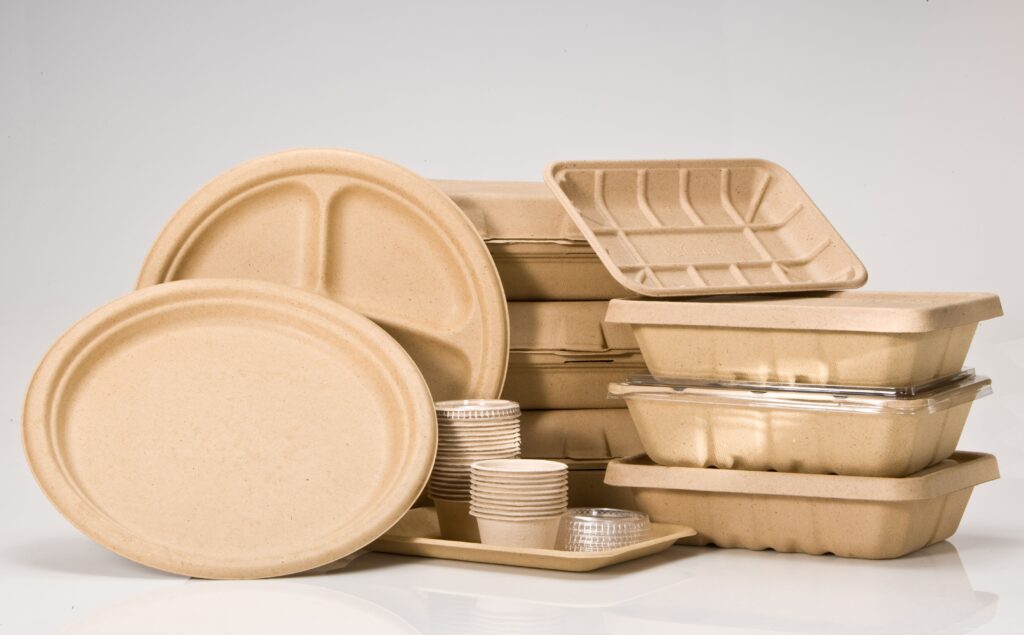
The global biodegradable disposable tableware market is set to witness significant growth over the next decade, with an anticipated compound annual growth rate (CAGR) of 4.3% from 2024 to 2034. According to recent market analysis, the market is projected to strengthen from US$ 12.2 billion in 2024 to an impressive US$ 22.7 billion by 2034. The market expansion is fueled by increasing environmental concerns, rising awareness of biodegradability, and growing demand for sustainable products globally.
The growing awareness about the benefits of sustainable products has also fueled the market in recent years. These are manufactured with bio-based plastic, paper and paperboard, and wood, which makes them completely biodegradable.
Growing number of restaurants, cafeterias, and food joints are expected to opt for this kind of tableware as they look for cost-efficient waste management solutions.
The food and beverage industry prefers disposable packaging to avoid washing trouble and convenience it provides to its users. Furthermore, innovations in the manufacturing of biodegradable tableware such as usage of leaf, bagasse, and starch extracted from various natural raw materials will increase production of the biodegradable disposable tableware market.
Request a report sample to gain comprehensive market insights: www.futuremarketinsights.com/reports…p-gb-11299
Key Takeaways of Biodegradable Disposable Tableware Market Study
- Paper & paperboard as a material is poised to account for more than 2/3 rd of the biodegradable disposable tableware market by 2030
- Bio-based biodegradable plastic segment is gaining significant traction as this plastic is made from renewable resources instead of fossil fuels, reducing carbon footprint. The segment is likely to witness a CAGR of 6.1% during the forecast period
- Trays are estimated to account for more than 45% of the market share by value during the forecast period
- The foodservice industry is estimated to be the key end user of biodegradable disposable tableware and is poised to account for over 60% of the global biodegradable disposable market by 2030
- Asia Pacific is estimated to represent an incremental opportunity of over US$ 5Bn by the end of next five years
Significant Availability of Raw Materials to Boost Production of Biodegradable Disposable Tableware in Asian Economies
In order to promote sustainable production of biodegradable disposable tableware and to gain economies of scale, the production and availability of the raw material is an important aspect. Asian countries account for more than 40% of bio-based materials including sugarcane and bamboo used for manufacturing biodegradable disposable tableware.
Thus, the region is estimated to provide a steady supply of raw material for manufacturing biodegradable disposable tableware market, thereby augmenting the market growth.
This is likely to provide a remunerative opportunity to the regional manufacturers to leverage the raw material availability and expand their production capacities.
“As per data provided by the United Nations, more than 8.3 billion tonnes of plastic has ended up in the landfills. Only 9% of plastic is recycled whereas the rest results in polluting the water bodies and natural environment.
Single-use plastics such as spoons, cups, and plates are widely used by food service industry are a continuous threat to the environment. Thus, green solutions such as bioplastics or use of disposable tableware made from natural resources is likely to boost the growth of the biodegradable disposable tableware market,” says an FMI analyst.
Key Market Drivers:
- Environmental Concerns and Pollution:
Increasing environmental awareness and concerns about pollution have significantly driven the demand for biodegradable disposable tableware. The detrimental impacts of plastic dinnerware on ecosystems and marine life have led to stricter government regulations on plastic usage, encouraging both producers and consumers to seek sustainable alternatives. - Corporate Social Responsibility (CSR):
Many businesses are adopting eco-friendly alternatives and sustainable practices to enhance their CSR reputation. This shift has led to a greater demand for biodegradable disposable tableware as companies aim to align with environmentally responsible practices. - Public Awareness and Media Influence:
Media coverage and educational initiatives highlighting the negative effects of plastic pollution have played a crucial role in shaping public opinion. This growing consciousness among consumers has spurred the demand for biodegradable disposable tableware. - Waste Management Challenges:
The difficulties associated with disposing of traditional plastic waste have also contributed to the shift towards biodegradable substitutes. Biodegradable tableware offers a solution to plastic pollution and reduces the burden on conventional waste management systems.
Contact us for Further Information about this report this Report: www.futuremarketinsights.com/checkout/11299
Key Segments
By Product Type:
- Plates
- Bowls
- Cups
- Trays
- Cutlery
By Material:
- Pulp and Paper
- Bioplastics
- Starch-based Bioplastic
- Polylactic Acid (PLA)
- Polybutylene Succinate (PBS)
- Polyhydroxybutyrate (PHB)
- Others (PHA, etc.)
By Packaging Application:
- Food
- Fresh-cut Fruits and Vegetables
- Processed Food Products
- Ready-to-eat Meals
- Soups
- Other Foods
- Beverages
- Carbonated Beverages
- Non-carbonated Beverages
By End-use:
- Commercial Use
- Full-service Restaurants
- Quick Service Restaurants
- Catering
- Others (Cafes, Lounges, etc.)
- Institutional Use
- Household Use
By Region:
- North America
- Latin America
- Europe
- East Asia
- South Asia
- Oceania
- Middle East and Africa (MEA)


